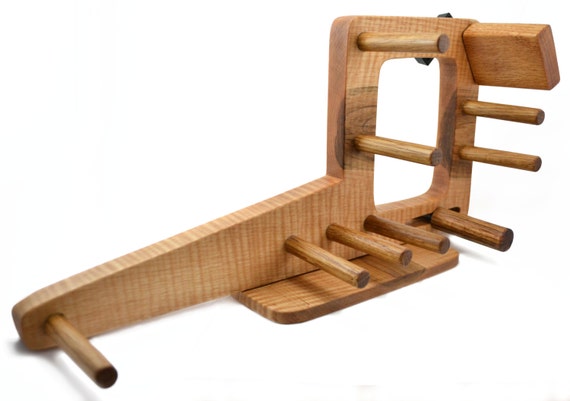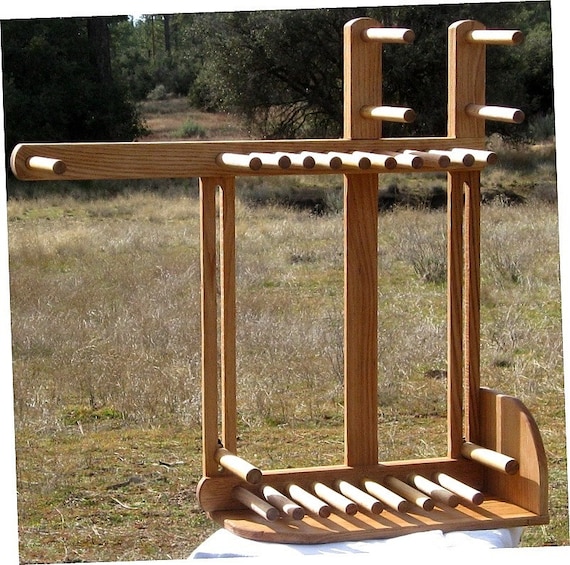Card Weaving (aka Tablet Weaving) is an older-than-you-think weaving technique of making narrow bands or finished edging on other woven goods. It's been found in Egyptian digs and Iron Age Finnish digs--and that's a lot of geography in between!
While it would be fun to go into all the history and things, you can find all that elsewhere, like
here, and
here, and any number of available
books on the market.
But I'm here to provide you with a step-by-step guide to starting your first tablet weaving project (or offer a refresher course if it's been a while). I've got two different projects going on in these photos...I apologize if this is confusing.
First you may need a quick overview of some of the weaving terms.
Warp - the threads that run the length of the work--on a bolt of fabric, it would be the 15 yards' length
Weft - the threads that run back and forth through the warp for the width of fabric.
Cards / Tablets - same thing. Four- or six-hole cards for weaving.
Shuttle - item the weft threads are wrapped around and is used for beating rows of weaving
Beating - the pressing down of each pass of the shuttle to compress the threads
Shed - opening between the top and bottom threads through which the shuttle passes.
Turning - changing the shed with the cards by rotating 1/4 turns
The supplies are rather simple:
- 2 to 3 colors of carpet warp or crochet cotton thread, high contrast--light, medium, dark. You can pick up crochet cotton pretty cheaply at just about any craft store. Michael's, JoAnn's, Walmart...whatever is closest to you. There are also several online options, like yarn.com, dickblick.com and greatnorthernweaving.com.
- 4-hole cards which can be purchased here, or here in packs of 25, or you can make your own here. I've seen people make them out of playing cards or cereal boxes or even bar coasters, but just be sure that the holes punched in them all line up.
- A loom. This is the trickiest bit. Some people like to have a backstrap loom, which means you anchor it to your waist by a belt then another fixed point, like a doorknob or a railing. This rather limits mobility, especially if you can only weave for a few minutes here and there, so others prefer to use a loom. Inkle looms are popular, especially if you are also interested in inkle weaving (two-shed weaving with heddles instead of cards).

<--- Some are miniature and only weave a couple yards of very narrow or delicate bands...
<---...others are enormous and can weave 18 yards or more of serious trim. Note that there are *two* sliding tension bars!
There are ways to create some simple loom systems that involve clamps and 2 x 4s...you'll have to do some research on the internet or Pinterest and find a loom system that will work for you. There are
plans to make a quick-and-dirty loom from PVC for about $10.
For a first weaving project or for testing new patterns, I would recommend starting with short lengths; try a one-yard project. If, after warping up 18 yards of a Loomzilla, you may decide that you hate the pattern and it'll take forever to take it apart and could result in yards of wasted materials. I warped up a loom for four yards of a brocade weaving project that I abandoned about 10" in. Luckily, I was able to use the thread for a 3 yard weaving project later.
If this is your first project, starting with something simple is the way to go. This is a nice one from the
Evil Queen of Spades on DeviantArt.com (sorry it's blurry):
If you follow the link, you will see she's got a number of great
patterns with both 4-hole and 6-hole cards (which, for beginners, is more advanced card weaving that you don't need to get involved in yet). I have tried several of them and love the way you can make it very different just by changing colors. Most look just like this pattern above--no card or hole numbering. I'll help you bridge that gap.
I did this up on Excel, which is how I do a lot of my patterns. Some people like to use
GTT or the
Loomybin, but I've had difficulty getting them to work for me. It's not the programs' fault--I'm just not that computer-savvy.

As you can see from this pattern, this one needs 12 cards. You will warp it up with the #1 card on the left, the #12 card on the right, just like reading a book. Number all your cards on the backs, 1-12 (in pencil). This will help you keep them organized.

The front of the cards have four holes, labeled A, B, C and D. Each hole will have one string in it; four strings per card. If you look above at the pattern, each square represents one thread. On Card 2, hole A is yellow, B is yellow, C is pale blue, and D is green; that's four threads running through one card.
The next logical question is "what is S and Z under the rows?" This is the way each card is threaded. This makes the threads angle inward or outward to create a pattern. It can make a difference between a wiggly line and a fuzzy line on your band. When you thread the card, all the threads must go through the card the same way--you can't have some of them S threaded and some Z threaded. That just won't work.
As you can see from this diagram (the card is the dark line in the center), S threading has the threads going from the back of the loom through the card from left to right. Z threading goes from right to left.

So above are two pictures: the left is S threaded--the threads go from the top peg through the front of the card...the right is Z threaded--the threads go from the top peg through the back of the card.
Warping board:
If you are using a warping board, you will need 18 dark strands, 20 medium strands, and 10 light strands of string. Since I use an inkle loom, I warp as I go, so I don't need to pre-cut any threads.

Warping:
If you are using an inkle, move your tension rod to the longest position. On my loom, because it has a switch-back, it's to the far right. (PS - the green elastic on there is to hold my shuttle during transport...this isn't an essential part of the loom.)

Lazy Kate:
In order to more easily pull threads to warp your loom, you may want to construct a Lazy Kate. There are some fancy ones out there that you can buy, but I went the quick-and-dirty route by using a cardboard box and a 1/2" dowel. Punched a couple holes in the box with a pair of pointy scissors, threaded the dowel through, and boom! Lazy Kate.
With all the spools on the Lazy Kate, you can pull all colors at once, saving precious time.

As I said, you will warp it up with the #1 card on the left, the #12 card on the right, and you will have the the top surface of the cards (with ABCD) facing left. If you have the cards facing right, the pattern will show up on the bottom of the weaving. Also, note that the pattern is lettered DCBA from top to bottom. If your pattern is written up as ABCD, the cards will have to face right...but that's notes for future pattern.

Tying the ends.
When I warp my loom, I leave long 3" tails for each thread. I put all four threads for one card together and tie the beginning and ends in a square knot. If there is an issue with one thread being too loose or breaking, you can much more easily fix it by isolating that one card and fixing the problem. Tying them individually can also create tension problems and mean four times as many knots in the end. Remember back to your Girl Guide or Scouting days--right over left and under, left over right and under.

Actually, I like to use a surgeon's knot, which is left over right and under twice, then right over left. This helps secure the knot and also makes untying the knots easier at the end. The warp needs to be taut, but you don't need to pull the warp super-tight. Too much tension on the warp can warp your pegs...so to speak.
Once all the cards are threaded and the tension looks even, it's time to begin!

Notes on shuttles.
Shuttles can be just about anything you want to use. I've used wooden rulers to hand-carved shuttles by masters of the craft. As long as it's rigid, does the job, and is comfortable for your hands, it's all good. Bonus: wooden rulers can be found for under a buck.
Wind several yards of weft threads (that's the name for the thread that goes from side to side--or from wight to weft...as I say...) onto your shuttle. Generally speaking, you will want to use the same color thread as the threads on the #1 and #12 cards (or whichever is the last card on the right). This will help blend the weft into the edges so any little mistakes in tension won't be glaringly obvious.
Turning the cards.
For this pattern, all the cards will turn 1/4 turn in the same direction. After four quarter-turns, you will reverse the direction and weave in the opposite direction.

As you can see in this image, I have colored one edge of the cards with a red permanent marker--this is the BC side. On the opposite side, the AD side, I have colored the edges blue. This helps you make sure you know where you are during the weaving process. The blue edge, when A and D are on the top, is the "home" position for many patterns. You can, of course, reverse directions at any time, but if you are going for a repeating pattern, knowing the home position is important.

Pass the shuttle through the shed (the opening between the upper and lower threads), and pull the thread down towards the knots on your warp. Turn all the cards 1/4 turn and pass the shuttle again. Press down--beat--with your shuttle.

You'll note that there's a little loop on the right side--this is left back to help maintain good tension. You don't want to get wobbly edges, so when you weave follow these steps:
* Pass the shuttle, leaving a loop behind
* Turn the cards
* Beat
* Pull the weft thread to incorporate loop
* Then repeat!
After a time, it becomes rather meditative.




 And finally, I set up and made some progress on the warp-weighted loom. Although I don't know if you can legitimately call it a "warp-weighted" loom if the warps are not yet weighted. I was talking with a couple of other weavers there, and they gave me some really great advise on how to proceed and tips on how to prevent issues. You can't see it very well in the display (below) so I took a picture of it set up in my living room.
And finally, I set up and made some progress on the warp-weighted loom. Although I don't know if you can legitimately call it a "warp-weighted" loom if the warps are not yet weighted. I was talking with a couple of other weavers there, and they gave me some really great advise on how to proceed and tips on how to prevent issues. You can't see it very well in the display (below) so I took a picture of it set up in my living room. 




























